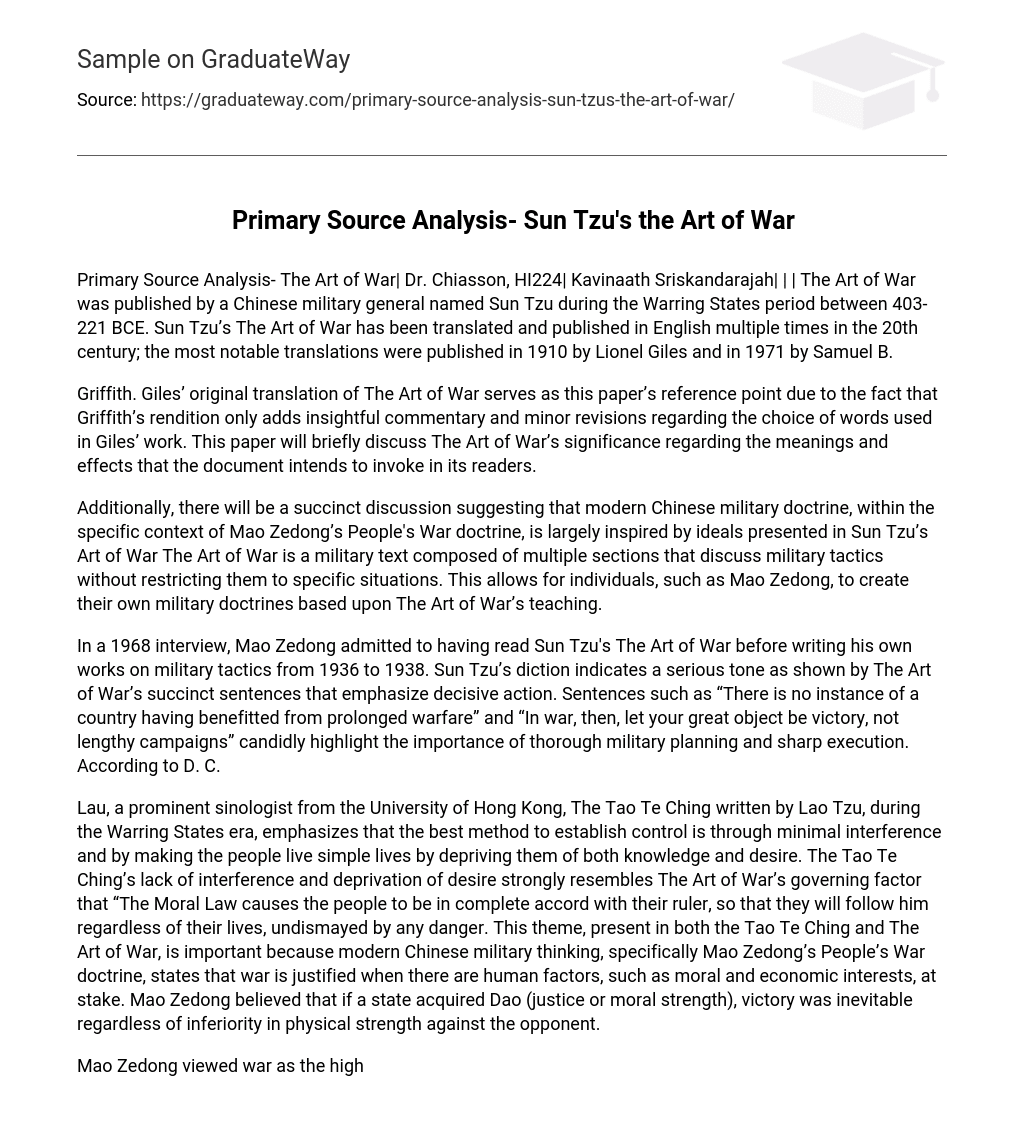Giles’ original translation of The Art of War serves as this paper’s reference point due to the fact that Griffith’s rendition only adds insightful commentary and minor revisions regarding the choice of words used in Giles’ work. This paper will briefly discuss The Art of War’s significance regarding the meanings and effects that the document intends to invoke in its readers.
Additionally, there will be a succinct discussion suggesting that modern Chinese military doctrine, within the specific context of Mao Zedong’s People’s War doctrine, is largely inspired by ideals presented in Sun Tzu’s Art of War The Art of War is a military text composed of multiple sections that discuss military tactics without restricting them to specific situations. This allows for individuals, such as Mao Zedong, to create their own military doctrines based upon The Art of War’s teaching.
In a 1968 interview, Mao Zedong admitted to having read Sun Tzu’s The Art of War before writing his own works on military tactics from 1936 to 1938. Sun Tzu’s diction indicates a serious tone as shown by The Art of War’s succinct sentences that emphasize decisive action. Sentences such as “There is no instance of a country having benefitted from prolonged warfare” and “In war, then, let your great object be victory, not lengthy campaigns” candidly highlight the importance of thorough military planning and sharp execution. According to D. C.
Lau, a prominent sinologist from the University of Hong Kong, The Tao Te Ching written by Lao Tzu, during the Warring States era, emphasizes that the best method to establish control is through minimal interference and by making the people live simple lives by depriving them of both knowledge and desire. The Tao Te Ching’s lack of interference and deprivation of desire strongly resembles The Art of War’s governing factor that “The Moral Law causes the people to be in complete accord with their ruler, so that they will follow him regardless of their lives, undismayed by any danger.
This theme, present in both the Tao Te Ching and The Art of War, is important because modern Chinese military thinking, specifically Mao Zedong’s People’s War doctrine, states that war is justified when there are human factors, such as moral and economic interests, at stake. Mao Zedong believed that if a state acquired Dao (justice or moral strength), victory was inevitable regardless of inferiority in physical strength against the opponent.
Mao Zedong viewed war as the highest manifestation of conscious action, distinctive mental and physical characteristics of soldiers at war such as the courage of the soldiers or the tactical skill of the commander. Mao Zedong’s conscious action concept and perception of Dao were both heavily influenced by the Art of War’s statement that “If a general shows con? dence in his men but always insists on his orders being obeyed, the gain will be mutual.
When reflecting on the Korean War at the Conference of the Central Government Committee in September 1953, Mao Zedong stated his belief that a truce was achieved with the Americans because of “… the fact that for us it is a people’s war which the Chinese people have fought shoulder to shoulder with the Korean people. ” Sun Tzu believed in setting examples, maintaining firm control of a situation, and being confident. A brief anecdote in The Art of War’s introduction illustrates how Sun Tzu addressed disobedient subordinates with severe punishment to establish discipline.
Additionally, Sun Tzu declared that “…the skillful leader subdues the enemy’s troops without any ? ghting… he overthrows their kingdom without lengthy operations in the ? eld. ” Sun Tzu does not acknowledge the fact that a series of lengthy campaigns may be of greater use than a few quick victories. British and Allied forces conducting a series of campaigns against the Germans throughout WWII was essential for the Allied victory. However, the Art of War was created during the Warring States era where lengthy campaigns were not suitable.
In the Cambridge History of Ancient China, Mark Edward Lewis characterizes the Warring States period as a period where a small number of territorial states were involved in constant diplomatic manoeuvring and intermittent but frequent large-scale military battles. This depiction of the Warring States explains the logic behind the actions of Sun Tzu and his belief that “Security against defeat implies defensive tactics; ability to defeat the enemy means taking the oensive”.
Mao Zedong’s People’s War policy also emphasized mobilization and favoured defensive tactics.These aspects of the People’s war remained unchanged into the 1980s where it was believed that “If war breaks out, we will [lure the enemy deep into China and] mobilize the masses of people to swamp the enemy in the ocean of people’s war”.
Bibliography
- Zhang Jhunbo and Yao Yunzhu. “Differences between Traditional Chinese and Western Military Thinking and their Philosophical Roots. Journal of Contemporary China 5, no. 12 (1996)
- Victor Mair. Tao Te Ching Lao by Lao Tzu. New York City: Bantam, 1990
- Lionel Giles. The Art of War by Sun Tzu Pax Libbrorum Publishing House, 2009,
- Harlan Jencks. “”People’s War Under Modern Conditions”: Wishful Thinking, National Suicide, Or Effective Deterrent? ” The China Quarterly no. 98 (1984)





